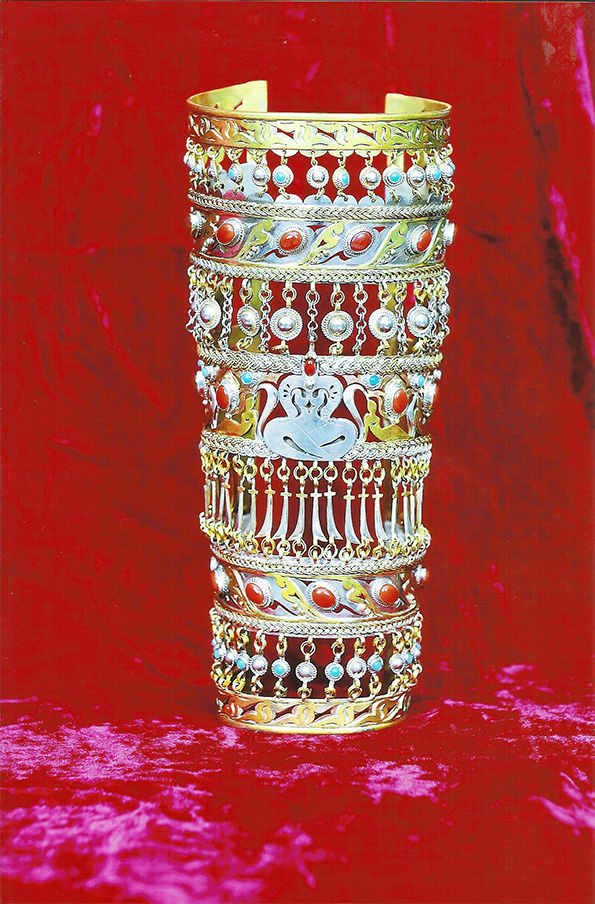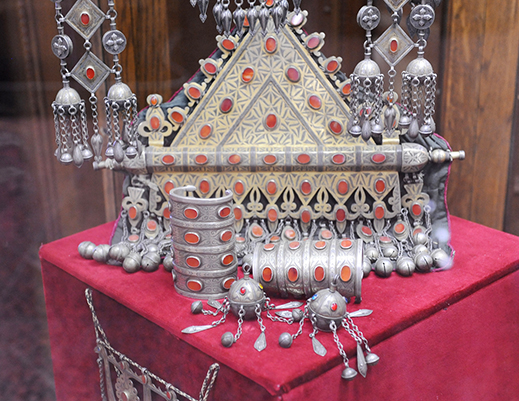Turkmen jewelry art is an integral part of the national cultural heritage, rooted in the depths of millennium. The archaeological excavations in the early settlements on the territory of Turkmenistan, the civilization of Ancient Merv and Ancient Nisa, as well as many others, testify to the long tradition of the Turkmen people in making jewelry.
Today, the products of the Turkmen zerger (master-jewellers) are included in the exposition of the best museum collections around the world. They are distinguished by beauty and harmony, attract by their originality, symmetry of patterns and unique features of the national ornament. Even in the distant past, jewellers learned how to masterfully combine gold and silver with precious stones, having developed not only traditions of impeccable technical craftsmanship, but artistic canons unmatched in aesthetic qualities.
A lot of interesting about jewellers keep folk legends. For example, one of the numerous requirements for a master is accuracy. In antiquity, when bows and arrows were the main weapon in wars, jewellers were also healers. They removed the pierced arrow from the body by means of a special silver tube, which had antiseptic properties and protected the wound from infection. Having the best tools for work, jewellers were at the same time “dentists”.
Jewelry is an integral part of the life of the turkmen, they were worn not only by women and children, but also by men. They decorated the akhal-teke horses as a sign of respect for warhorses and to protect them from evil and disease. These amazing products were created not only as a decorative addition to the dress, but also as magic talismans. It is in the jewelry symbolism inherent in all national art, manifests itself particularly vividly and exciting. The form, the location of the stones, the proportions, the composition, the ornament - all this carried a magical meaning. Even the choice of silver was not accidental - according to ancient superstitions, it had healing and protective properties. For decoration most often used semi-precious stones: turquoise, corals, carnelian, jade. But the most beloved was to this day the carnelian, a stone that brings abundance, happiness and peace to the house, and its owner the health and protection from the evil eye.
Turkmen women's jewelry often resembles the armor of ancient warriors. Some of them are surprisingly similar to the helmet of an ancient knight, others - are associated with chain mail protecting against arrows and spears. And the massive bracelets covering the hand from hand to elbow are identical in shape to steel sleeves.
The very first adornments of small children were wards - silver bells and plates of different configurations, which they sewed on clothes, protecting children from diseases or the evil eye. Children's jewelry had a purely practical value. When the child began to walk, bracelets with bells were worn on his legs, the sound of which the mother could easily determine where her child was. Girls and young women wore massive jewelry on their heads, breasts, on their necks, hands, braids and clothes, while women of old age were lightweight and made of pure silver. By the age of marriage, the amount of jewelry increased in girls. The amount of jewelry that a woman wore decreased with age after marriage and childbirth; an elderly woman wore only two amulets.
A young girl was given a silver “cap” with a “gupba” and “checkelek” hanging from it. This item symbolized her willingness to marry. Putting on a silver gupba, crowning the head skullcap like the sultan, the girl unwittingly developed a graceful gait and plastic of movements. The traditional bridal outfit at the wedding weighed 20 kg.

The future mother-in-law of the bride gave her a decoration that represents two metal hearts welded together. The number of whorls in the lower part of the jewelry symbolizes the estimated (desired) number of children.
Jewelry for boys bring up in them a feeling of defenders of the Motherland. Thus, a child’s amulet in the form of a stylized bow with an arrow, symbolizing courage, was sewn onto the back of the boy’s robe so that he would grow strong and brave. Men wore only a silver belt to which a dagger was attached.
From the end of the 19th century to the present day, no Turkmen can do without a brooch-fastener - a solar “gulyaka”, which is pinned to the collar of the dress. In everyday life, women continue to wear vintage talismans - fancy plates with coins.
The traditions of medieval jewellers are amazing. Learning the skills of the zerger was considered an honorable and respected occupation. It took five years of study to acquire the necessary skills. During this period, the master provided the student with the tools and necessary materials. For the dedication of the student to the independent work, the best jewellers gathered, and the graduate held the mastery exam. If he was considered worthy, the teacher traditionally gave him the tools and materials for the work. But even during the whole year the young master, before offering his goods for sale, was obliged to show each item to the teacher. In ancient Merve there were streets of saddler, potters, jewellers. Masters with unquestioned authority rode the stalls on horses, not allowing jewelry of high enough quality to be sold. It was very important to share experience, their own methods and skills, so that technical techniques, the creation of patterns, ornaments, shapes and colors could be preserved and developed. Perhaps due to precisely such rigid rules, the Turkmen jewelry art has reached a high level.
Another unique tradition among zergers is making their own professional tools. The main tools of the jeweller are a small anvil, called “sandalwood”, sharpened on one side, a hammer or “chukech”, which had the shape of a miniature anvil with various tools for working with metal, for striking and shaping the metal, and a pair of nippers, called “zahambar” ". The student was involved in the manufacturing process of these tools to ensure that he acquired all the necessary professional skills. These handcrafted tools today are greatly appreciated compared to some modern tools.
Over time, the Turkmen jewelry art was transformed, but it retained many elements of traditionalism. Decorations have become less overall and lighter, because before the set of women's jewelry sometimes weighed up to 8 kilograms. Previously, only men were engaged in jewelry business, because this profession required special skills in working with metal, in the 20th century any capable teenager could become a student, and nowadays a woman-jeweller is not uncommon.
Today, Turkmen jewellers create truly national works, continuing the traditions of past masters. A unique collection of women's jewelry is stored in the State Museum of the State Cultural Center of Turkmenistan. Tourists visiting Turkmenistan can not only admire them in the museums of the country, but also purchase them in shopping centers, specialized stores and, according to the tradition that has developed since ancient times, in the bazaars.


